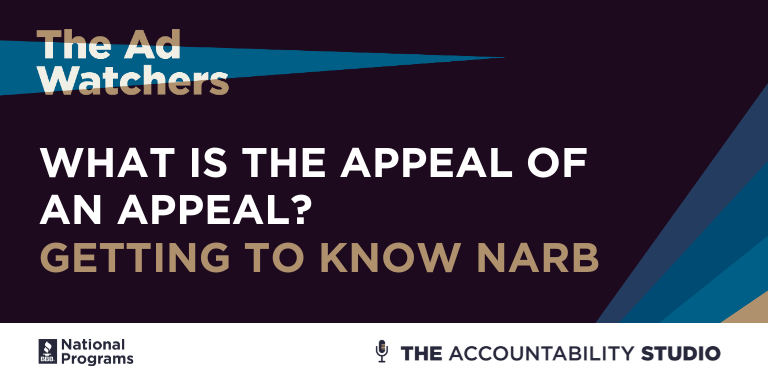
On this episode of Ad Watchers, host Daniel Range, Attorney at the National Advertising Division (NAD), is joined by an all-star team from the National Advertising Review Board (NARB), BBB Programs. Ken Plevan, Chair, Heather Hippsley, Vice-Chair, and Saveeta Dhanai, Manager, all gather to discuss who makes up the National Advertising Review Board (N ARB) and the role this organization plays in the advertising self-regulation space.
Dan leads the conversation by asking Ken to give listeners a general overview of the NARB and its function. Ken begins by reminding us that NARB is informal and voluntary. Companies participating in the NAD process who are unhappy with the decision issued have an opportunity to appeal, which is done through NARB. Unsatisfied NAD participants can ask their colleagues within the industry to tell them whether what they are doing is right, wrong, or defensible. This request transforms into a review board comprised of five industry peers.
8:56 After Ken’s summary, Dan asks him to provide listeners with an estimate of how many cases come before NARB annually. Ken mentions that there are about 10 – 17 panels a year, amounting to about 35% of cases advertisers could appeal. These numbers suggest that the NAD process is highly efficient. These results mean that the advertiser agrees with 70-75% of the rulings made by the NAD. “So it’s a strength on both sides of the process. NARB is there, and it’s used. On the other hand, NAD typically has their decision accepted,” Ken highlights.
Dan pivots the conversation towards discussing the types of decisions that are eligible for appeal. He invites Heather to discuss this matter in more detail. Heather begins by clarifying that the NARB panel takes a relook at the NAD outcome based on the merits of the decision by the self-regulation organization. “A new look by your panel of peers, so they don’t have any deference to what the NAD decided,” Heather describes. “It starts anew with the same information that NAD used to make a decision, but they reexamine the advertising and decide whether they agree with what happened,” Heather further explains.
There is the opportunity for either party to bring a non-merit appeal before NARB. These appeals go directly to the Chair and the Vice Chair to decide the issues. A peer panel is not involved in a non-merit appeal. Heather does forewarn, however, that there has to be a clear error at the NAD for any decision on NARB’s part to differ. There needs to be something very egregious that must have gone wrong, but there is room to correct that.
16:00- Dan then asks Saveeta to describe the appeal process. She helps listeners understand what to expect when an appeal is presented to the NARB. An initiation letter is sent to the advertisers initiating the appeal. The letter provides a brief overview of the appeals process. It includes information on invoicing, consolidating all materials related to the NAD case into one case record, and scheduling the submission of briefs through the organization’s online portal. The letter also mentions important dates such as the hearing date, pre-hearing meeting dates, and submission deadlines for any planned presentation materials.
20:08- The team further dives into the appeal process, taking listeners through the hearing of the arguments. Dan asks guests to share what deliberation looks like. Heather shares that the panel will usually try to reach a consensus on what they want to do, deliberating while it’s fresh in their mind. Typically, it only requires one session. For more complex cases, a panel may want to digest more of the information they’ve received. If that occurs, they’ll schedule a second time to get together to decide. Within 1-3 days of the hearing, a decision is usually ready to be sent to the parties for review.
Ken shares with listeners that the overall review process, from the advertiser’s statement through a decision being forwarded to the advertiser for its review, takes approximately two and a half to three months. He then speaks to the post-decision activities involved in the process concerning the advertiser and its compliance. After reviewing the decision, the advertiser can either accept or reject the decision and does so by providing NARB with an ad statement.
Dan explains that the post-decision process and options for NARB are the same as those available through NAD. Both organization’s post-decision processes weigh heavily on the advertiser’s decision to comply with the decision or not.
Dan also shares with listeners that this is the last episode of season three and reminds them that they can listen to this episode and prior ones wherever they enjoy listening to podcasts most. Subscribe to Ad Watchers and be the first to receive an alert when season four begins!
Visit to Learn More: NAD FAQs
Contact Information: programs@bbbnp.org
Listen to the full episode here.

